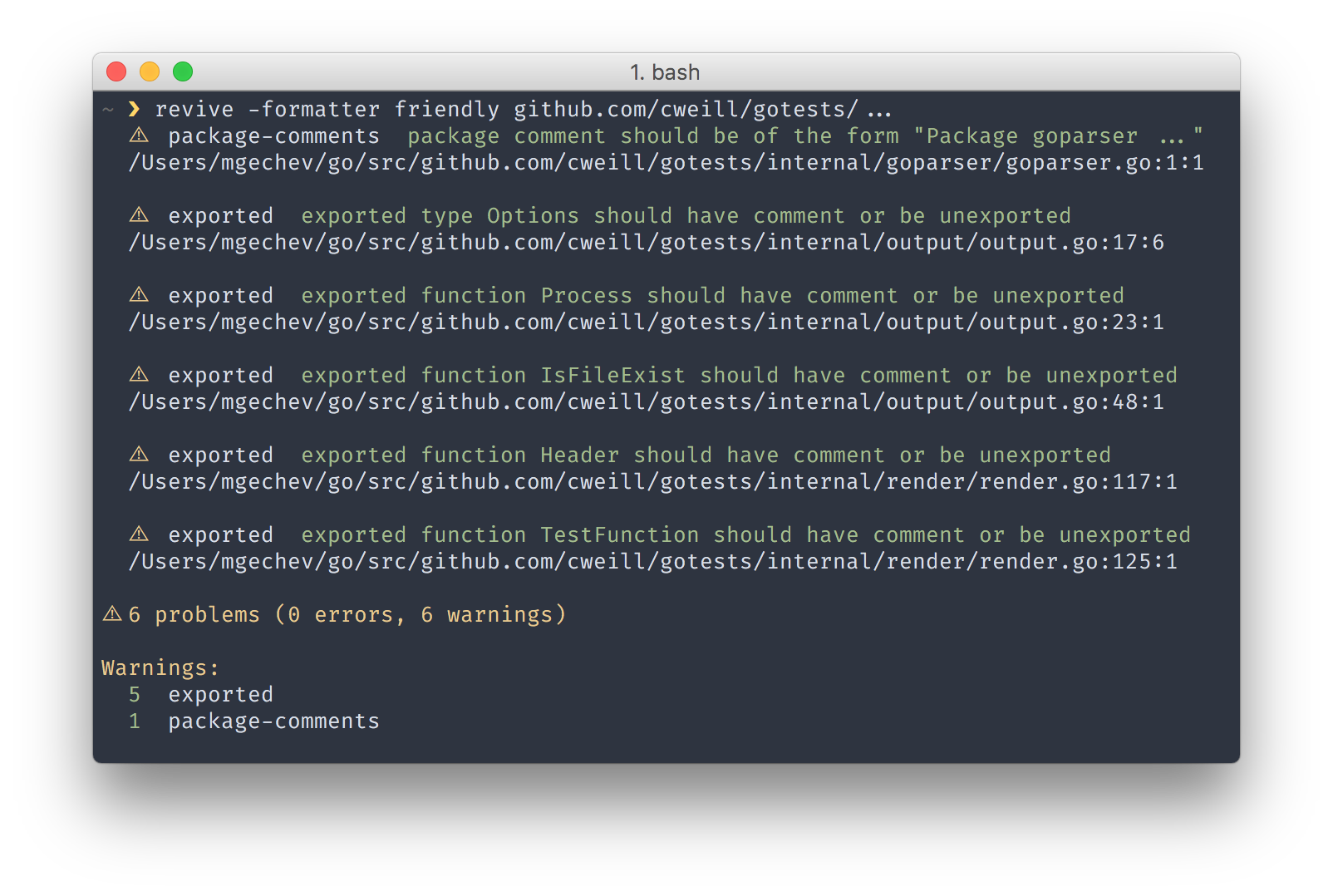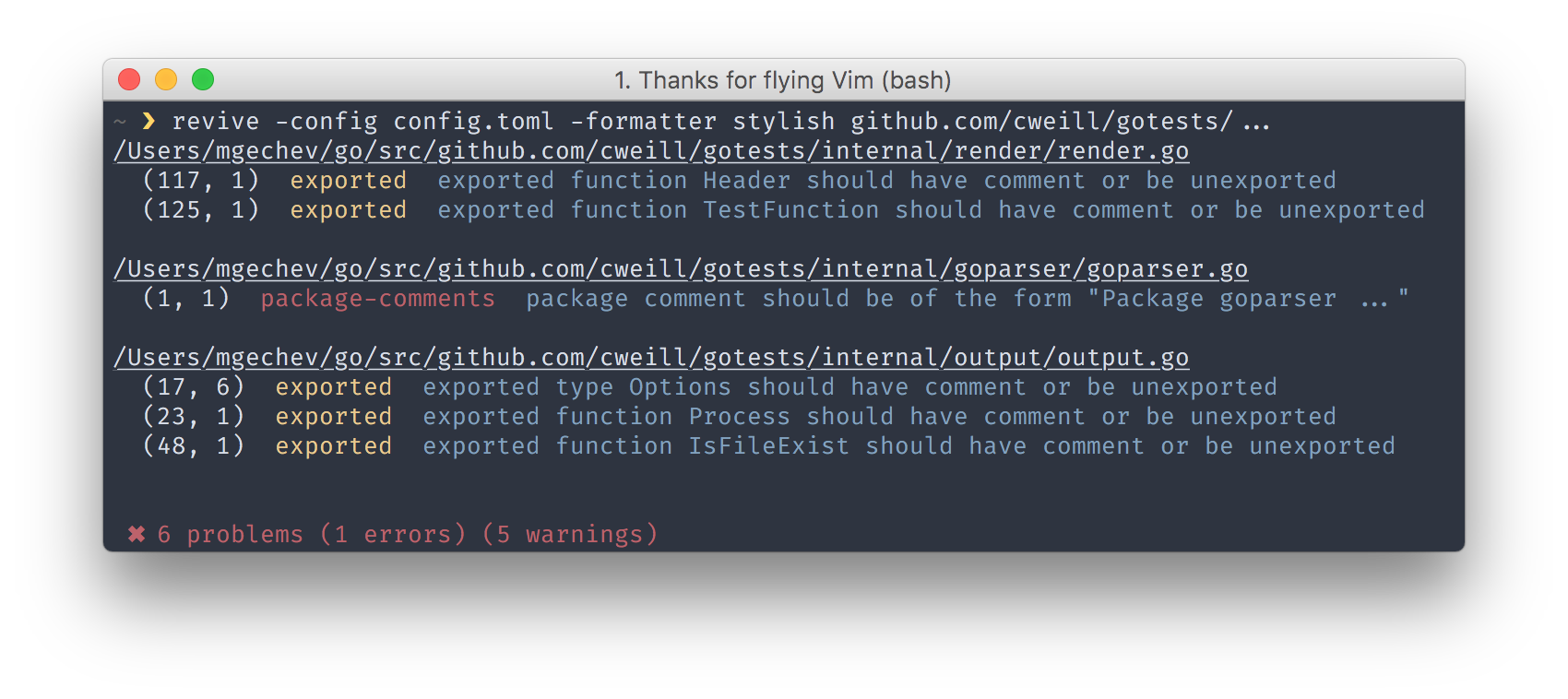Cyan for readability (better contrast)
revive
Fast, configurable, extensible, flexible, and beautiful linter for Go. Drop-in replacement of golint. Revive provides a framework for development of custom rules, and lets you define a strict preset for enhancing your development & code review processes.

Logo by Georgi Serev
Here's how revive is different from golint:
- Allows us to enable or disable rules using a configuration file.
- Allows us to configure the linting rules with a TOML file.
- 2x faster running the same rules as golint.
- Provides functionality for disabling a specific rule or the entire linter for a file or a range of lines.
golintallows this only for generated files.
- Optional type checking. Most rules in golint do not require type checking. If you disable them in the config file, revive will run over 6x faster than golint.
- Provides multiple formatters which let us customize the output.
- Allows us to customize the return code for the entire linter or based on the failure of only some rules.
- Everyone can extend it easily with custom rules or formatters.
Reviveprovides more rules compared togolint.
Usage
Since the default behavior of revive is compatible with golint, without providing any additional flags, the only difference you'd notice is faster execution.
Text Editors
- Support for VSCode in vscode-go.
Installation
go get -u github.com/mgechev/revive
Command Line Flags
revive accepts three command line parameters:
-config [PATH]- path to config file in TOML format.-exclude [PATTERN]- pattern for files/directories/packages to be excluded for linting. You can specify the files you want to exclude for linting either as package name (i.e.github.com/mgechev/revive), list them as individual files (i.e.file.go), directories (i.e../foo/...), or any combination of the three.-formatter [NAME]- formatter to be used for the output. The currently available formatters are:default- will output the failures the same way thatgolintdoes.json- outputs the failures in JSON format.friendly- outputs the failures when found. Shows summary of all the failures.stylish- formats the failures in a table. Keep in mind that it doesn't stream the output so it might be perceived as slower compared to others.
Sample Invocations
revive -config revive.toml -exclude file1.go -exclude file2.go -formatter friendly github.com/mgechev/revive package/...
- The command above will use the configuration from
revive.toml revivewill ignorefile1.goandfile2.go- The output will be formatted with the
friendlyformatter - The linter will analyze
github.com/mgechev/reviveand the files inpackage
Comment Annotations
Using comments, you can disable the linter for the entire file or only range of lines:
//revive:disable
func Public() {}
//revive:enable
The snippet above, will disable revive between the revive:disable and revive:enable comments. If you skip revive:enable, the linter will be disabled for the rest of the file.
You can do the same on a rule level. In case you want to disable only a particular rule, you can use:
//revive:disable:unexported-return
func Public() private {
return private
}
//revive:enable:unexported-return
This way, revive will not warn you for that you're returning an object of an unexported type, from an exported function.
Configuration
revive can be configured with a TOML file. Here's a sample configuration with explanation for the individual properties:
# When set to false, ignores files with "GENERATED" header, similar to golint
ignoreGeneratedHeader = true
# Sets the default severity to "warning"
severity = "warning"
# Sets the default failure confidence. This means that linting errors
# with less than 0.8 confidence will be ignored.
confidence = 0.8
# Sets the error code for failures with severity "error"
errorCode = 0
# Sets the error code for failures with severity "warning"
warningCode = 0
# Configuration of the `cyclomatic` rule. Here we specify that
# the rule should fail if it detects code with higher complexity than 10.
[rule.cyclomatic]
arguments = [10]
# Sets the severity of the `package-comments` rule to "error".
[rule.package-comments]
severity = "error"
Default Configuration
The default configuration of revive can be found at defaults.toml. This will enable all rules available in golint and use their default configuration (i.e. the way they are hardcoded in golint).
revive -config defaults.toml github.com/mgechev/revive
This will use the configuration file defaults.toml, the default formatter, and will run linting over the github.com/mgechev/revive package.
Recommended Configuration
revive -config config.toml -formatter friendly github.com/mgechev/revive
This will use config.toml, the friendly formatter, and will run linting over the github.com/mgechev/revive package.
Available Rules
List of all available rules. The rules ported from golint are left unchanged and indicated in the golit column.
| Name | Config | Description | golint |
Typed |
|---|---|---|---|---|
context-keys-type |
n/a | Disallows the usage of basic types in context.WithValue. |
yes | yes |
time-naming |
n/a | Conventions around the naming of time variables. | yes | yes |
var-declaration |
n/a | Reduces redundancies around variable declaration. | yes | yes |
unexported-return |
n/a | Warns when a public return is from unexported type. | yes | yes |
errorf |
n/a | Should replace error.New(fmt.Sprintf()) with error.Errorf() |
yes | yes |
blank-imports |
n/a | Disallows blank imports | yes | no |
context-as-argument |
n/a | context.Context should be the first argument of a function. |
yes | no |
dot-imports |
n/a | Forbids . imports. |
yes | no |
error-return |
n/a | The error return parameter should be last. | yes | no |
error-strings |
n/a | Conventions around error strings. | yes | no |
error-naming |
n/a | Naming of error variables. | yes | no |
exported |
n/a | Naming and commenting conventions on exported symbols. | yes | no |
if-return |
n/a | Redundant if when returning an error. | yes | no |
increment-decrement |
n/a | Use i++ and i-- instead of i += 1 and i -= 1. |
yes | no |
var-naming |
n/a | Naming rules. | yes | no |
package-comments |
n/a | Package commenting conventions. | yes | no |
range |
n/a | Prevents redundant variables when iterating over a collection. | yes | no |
receiver-naming |
n/a | Conventions around the naming of receivers. | yes | no |
indent-error-flow |
n/a | Prevents redundant else statements. | yes | no |
argument-limit |
int | Specifies the maximum number of arguments a function can receive | no | no |
cyclomatic |
int | Sets restriction for maximum Cyclomatic complexity. | no | no |
max-public-structs |
int | The maximum number of public structs in a file. | no | no |
file-header |
string | Header which each file should have. | no | no |
Available Formatters
This section lists all the available formatters and provides a screenshot for each one.
Friendly
Stylish
Default
Extensibility
The tool can be extended with custom rules or formatters. This section contains additional information on how to implement such.
To extend the linter with a custom rule or a formatter you'll have to push it to this repository or fork it. This is due to the limited -buildmode=plugin support which works only on Linux (with known issues).
Custom Rule
Each rule needs to implement the lint.Rule interface:
type Rule interface {
Name() string
Apply(*File, Arguments) []Failure
}
The Arguments type is an alias of the type []interface{}. The arguments of the rule are passed from the configuration file.
Example
Let's suppose we have developed a rule called BanStructNameRule which disallow us to name a structure with given identifier. We can set the banned identifier by using the TOML configuration file:
[rule.ban-struct-name]
arguments = ["Foo"]
With the snippet above we:
- Enable the rule with name
ban-struct-name. TheName()method of our rule should return a string which matchesban-struct-name. - Configure the rule with the argument
Foo. The list of arguments will be passed toApply(*File, Arguments)together with the target file we're linting currently.
A sample rule implementation can be found here.
Custom Formatter
Each formatter needs to implement the following interface:
type Formatter interface {
Format(<-chan Failure, RulesConfig) (string, error)
Name() string
}
The Format method accepts a channel of Failure instances and the configuration of the enabled rules. The Name() method should return a string different from the names of the already existing rules. This string is used when specifying the formatter when invoking the revive CLI tool.
For a sample formatter, take a look at this file.
Speed Comparison
Compared to golint, revive performs better because it lints the files for each individual rule into a separate goroutine. Here's a basic performance benchmark on MacBook Pro Early 2013 run on kubernetes:
golint
time golint kubernetes/... > /dev/null
real 0m54.837s
user 0m57.844s
sys 0m9.146s
revive
# no type checking
time revive -config untyped.toml kubernetes/... > /dev/null
real 0m8.471s
user 0m40.721s
sys 0m3.262s
Keep in mind that if you use rules which require type checking, the performance may drop to 2x faster than golint:
# type checking enabled
time revive kubernetes/... > /dev/null
real 0m26.211s
user 2m6.708s
sys 0m17.192s
Currently, type checking is enabled by default. If you want to run the linter without type checking, remove all typed rules from the configuration file.
License
MIT



